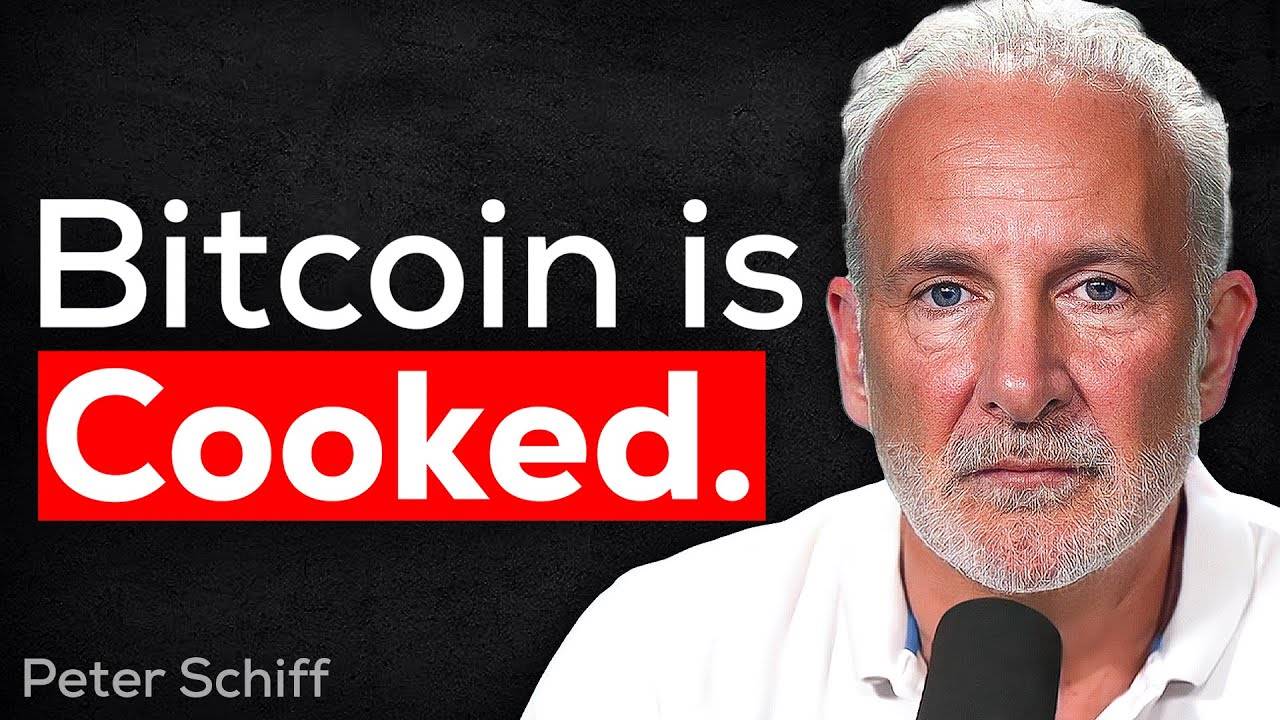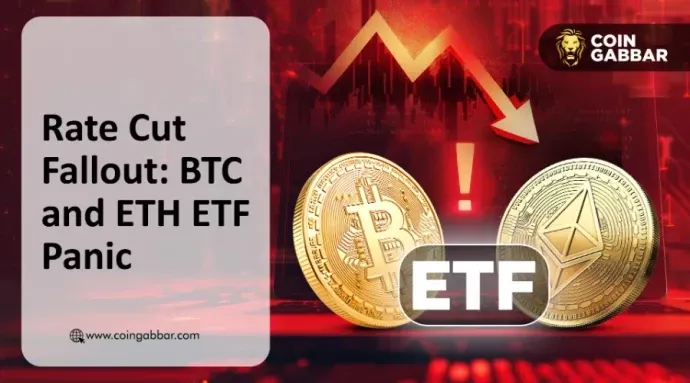In the 15 years that Bitcoin has risen from a few cents to $100,000, he has consistently been bearish, becoming the most famous "contrarian indicator" in the crypto world.
Compiled by: Deep Tide TechFlow

Guest: Peter Schiff, American stockbroker and financial commentator
Host: Michael Jerome
Podcast Source: threadguy
Original Title: Peter Schiff: Gold vs Bitcoin, Market Crashes, US Dollar Crisis and More | TG Podcast
Broadcast Date: October 23, 2025
Key Takeaways
Peter Schiff, Wall Street's most famous "gold bug," a staunch believer in the Austrian School of Economics, and the most controversial "opposition spokesperson" in the cryptocurrency community. In the 15 years that Bitcoin has risen from a few cents to $100,000, he has consistently been bearish, becoming the most famous "contrarian indicator" in the crypto world.
In October 2025, he even launched his own tokenized gold product, attempting to transform gold using blockchain technology. This move immediately sparked public skepticism from Binance founder CZ, and the two agreed to hold a "Gold vs Bitcoin" debate in Dubai.
In this podcast, Schiff once again elaborated on his views regarding Bitcoin, gold, and the future of currency. Whether or not you agree with his perspective, the logic and arguments of this "dissenter in the crypto world" are worth serious consideration by every investor. Below is the complete transcript of the podcast.
Highlights
The misunderstanding of gold by Bitcoin supporters mainly stems from their defense of Bitcoin, as Bitcoin itself has no intrinsic value. Holding Bitcoin means you can’t really do anything with it.
I still believe Bitcoin will ultimately go to zero. I don’t think my prediction is wrong; the real mistake was underestimating the public's blind faith in it and the marketing abilities of those promoting Bitcoin.
The core issue this time is no longer mortgages or subprime loans, but the sovereign debt crisis of U.S. Treasury bonds. In other words, the key to this crisis is the global loss of confidence in the U.S. government's ability to repay its sovereign debt.
Central banks around the world have begun to quietly reduce their dollar reserves and increase their gold reserves. I believe gold will once again become the primary reserve asset globally in the future.
If there are cryptocurrency enthusiasts among your audience, my advice is: hurry up and buy some gold and silver.
The cryptocurrency market is a massive bubble, where early entrants profit by selling at high prices to later investors, while those who ultimately take the risk may suffer huge losses.
No bubble can last forever. Bitcoin essentially has no intrinsic value, and its price entirely depends on the influx of speculators.
Misunderstanding of Gold by Bitcoin Supporters
Host: As a critic of Bitcoin, what do you think is the biggest misunderstanding Bitcoin supporters have about gold?
Peter:
Their misunderstanding of gold mainly stems from their defense of Bitcoin, as Bitcoin itself has no intrinsic value. Holding Bitcoin means you can’t really do anything with it. You can transfer it to others, but they also can’t do anything practical with it.
They view gold as a "worthless rock," believing its value is merely subjective, but they overlook the fact that gold does have intrinsic value, which is why it can serve as money.
Bitcoin's design does mimic some key characteristics of gold, such as fungibility, durability, divisibility, and portability. These characteristics have historically made gold a better choice for currency than other commodities. But the problem is, Bitcoin lacks the intrinsic value of gold. Something without value, even if it possesses these characteristics, cannot serve as a true store of value.
Gold is one of the most useful metals on the periodic table; even after hundreds of years, gold retains its physical and chemical properties, which is why it can serve as a store of value. In contrast, Bitcoin has no practical use and cannot store value. Although it has some interesting technological features, these features are not unique; thousands of other cryptocurrencies can offer similar functionalities, and theoretically, there is no limit to the number of cryptocurrencies, which further undermines their scarcity.
The cryptocurrency market is a massive bubble, where early entrants profit by selling at high prices to later investors, while those who ultimately take the risk may suffer huge losses. This dynamic is destined to cause the bubble to burst, and most investors will become victims.
Why Bitcoin Will Ultimately Go to Zero
Host: In 2017, you predicted that Bitcoin would go to zero, but now its price has reached new heights. Do you think your prediction was wrong?
Peter:
I still believe Bitcoin will ultimately go to zero. I don’t think my prediction is wrong; the real mistake was underestimating the public's blind faith in it and the marketing abilities of those promoting Bitcoin. I have to admit that those who entered the Bitcoin market early were very skilled at packaging and promoting the concept, convincing people that Bitcoin was worth investing in. Their goal was clear: to attract more people to buy the Bitcoin they held, thereby driving up the price to facilitate their own sell-off, which is essentially a typical "pump and dump" operation.
This has happened many times in recent years. For example, the launch of Bitcoin ETFs and Trump's election as President of the United States. I believe the cryptocurrency industry played a role in Trump's election because they hoped to boost the prices of Bitcoin and other cryptocurrencies through this political environment. It has been proven that these early investors indeed made huge profits this way. But because of this, Bitcoin's price has basically stagnated after reaching its peak.
If we measure it against gold, Bitcoin's value is declining. The price of Bitcoin has dropped about 30% from its peak. When priced in gold, it once reached 126,000, and now it's about 108,000. From this perspective, Bitcoin is actually in a "bear market."
The Rise of Gold and the Upcoming Currency Reset
Host: This year, gold has performed exceptionally well, achieving its best record since 1979. Can you explain to our audience, especially younger viewers, why gold has performed so well? What are the driving factors behind it?
Peter:
If there are cryptocurrency enthusiasts among your audience, my advice is: hurry up and buy some gold and silver.
Gold has performed well this year because the current economic environment is very similar to that of the 1970s. At that time, we faced stagflation (economic stagnation accompanied by high inflation) and also experienced a significant change in the global monetary system. In 1971, President Nixon announced the dollar's departure from the gold standard. Before that, the dollar was linked to gold, and the dollar was not only backed by gold but could also be directly exchanged for gold. Therefore, the global monetary system at that time was essentially operating on a gold basis, even though it was nominally centered around the dollar.
Now, we are experiencing a similar adjustment in the monetary system. The world is gradually moving away from dependence on the dollar. In fact, this shift should have happened back in the 1970s, but the process was delayed because the dollar still held a dominant position. However, in recent years, due to the U.S. budget deficit, trade deficit, and frequent use of economic sanctions, more and more countries have become dissatisfied with the dollar system. Central banks have begun to quietly reduce their dollar reserves and increase their gold reserves.
I believe gold will once again become the primary reserve asset globally. While this does not necessarily mean a return to the gold standard (where currency is directly linked to gold), central banks may hold more gold rather than dollars, euros, or pounds. Gold will become the core asset that central banks use to maintain the value of their currencies.
For the U.S., this will be a huge shift. We will no longer be able to buy goods we cannot produce by printing money, nor can we maintain high consumption levels through borrowing. This means the cost of living in the U.S. will rise significantly, and borrowing costs will also increase dramatically. At the same time, asset prices (such as stocks and real estate) will significantly decline in real value. Although nominally these assets may not change much, when priced in gold, their value has already plummeted. For example, since 1999, the Dow Jones Industrial Average has quadrupled in dollar terms, but it has fallen by over 70% relative to gold.
Assets are losing value, and this situation will continue and accelerate because the world is truly transitioning from a dollar standard back to a gold standard.
Peter Predicts a Financial Crisis Worse than 2008
Host: You mentioned that the upcoming financial crisis will be worse than the 2008 subprime crisis. What does this specifically mean? How will this crisis occur, and in what form will it manifest? What signs indicate it is coming?
Peter:
First, we need to review the 2008 crisis. The core of that crisis was a debt problem, initially triggered in the subprime mortgage market, which then gradually spread to financial institutions and insurance companies. Fortunately, the U.S. government managed to avoid more severe consequences through massive bailouts and stimulus policies at that time. Without these measures, the impact of the crisis would have been much more severe. Although these bailouts alleviated the problem in the short term, they merely postponed the issue to the future.
The upcoming crisis is completely different from 2008. The core issue this time is no longer mortgages or subprime loans, but the sovereign debt crisis of U.S. Treasury bonds. In other words, the key to this crisis is the global loss of confidence in the U.S. government's ability to repay its sovereign debt.
This crisis is not just a sovereign debt crisis; it is also a currency crisis. Its impact will far exceed that of 2008 because it directly undermines the credibility of the dollar— the cornerstone of the global financial system. If global investors no longer trust the dollar and are unwilling to purchase U.S. Treasury bonds, then the U.S. government will lose its ability to bail itself out. The Federal Reserve will also be powerless because, in 2008, the Fed could replace those "bad debts" by issuing dollars or bonds, but now global confidence in the dollar and Treasury bonds is collapsing.
Worse still, this crisis will lead to a sharp devaluation of the dollar, a rapid rise in inflation, while the government will be unable to take effective measures to respond. Because if they try to solve the problem by printing more money, it will only further increase inflation and accelerate the devaluation of the dollar, ultimately creating a vicious cycle.
We have fallen into a dilemma. For decades, the government has tried to avoid pain through short-term measures, but this has only compounded the problems. Now, the cost of resolving these issues is higher than ever, and the impact of this crisis will be more profound than that of 2008.
How the Collapse of U.S. Sovereign Debt Will Unfold
Host: What will the specific scenario look like when things start to deteriorate? What do you think will be the first obvious sign of the crisis?
Peter:
I believe the movement of gold prices is a very good warning signal. For example, last week gold prices approached $4,400 before retreating to around $4,000. Nevertheless, this price is still double what it was two years ago.
Looking back in history, around 1980, the world lost confidence in the dollar and began to sell it off. At that time, we took two key measures to restore trust. First, Federal Reserve Chairman Paul Volcker allowed short-term interest rates to soar to 20%, sending a clear message to investors: "If you are willing to hold dollars, we will give you 20% interest in return." This was a very enticing condition at the time, as inflation rates were only about 10% to 12% at their peak. Second, the Reagan administration further stabilized market confidence through tax cuts and economic reforms.
However, the current situation is completely different. First, the current leadership is entirely different from the decision-makers of that time. Even if Paul Volcker himself returned to today's Federal Reserve, he would not be able to implement similar policies. The reason is simple: we can no longer afford such high interest rates. The total U.S. national debt has reached $38 trillion, while in 1980, it was less than $1 trillion.
Worse still, a large portion of today's debt is financed through short-term borrowing. About one-third of our national debt will mature within a year, and the average maturity of all national debt is only four to five years. If interest rates rise to 10%, interest payments alone could reach $4 trillion, while the U.S. government's annual tax revenue is only about $5 trillion. In this situation, the government would be unable to pay interest, let alone repay the principal.
Most countries typically finance their debt through long-term bonds, so even if interest rates rise to 20%, it would not immediately have a significant impact on the budget, as these debts are locked in at lower rates and will mature over the next 10, 20, or 30 years. However, the current situation in the U.S. is different. About one-third of the national debt will mature within a year, and the average maturity of the entire $38 trillion debt is only four to five years, which is considered short-term debt.
If interest rates rise to 10%, the U.S. government will face enormous fiscal pressure. Interest payments on the debt alone could reach $4 trillion, while our current total tax revenue is only $5 trillion. Such high interest payments would make it difficult for the government to maintain normal operations. At the same time, high interest rates would lead to a wave of bankruptcies among businesses and households, a sharp rise in unemployment, a significant drop in tax revenue, and an expanding budget deficit.
Thus, the U.S. government finds itself in a dilemma: on one hand, if it raises interest rates to curb inflation, the economy may collapse due to high rates; on the other hand, if it does not raise rates, inflation will spiral out of control, ultimately leading to hyperinflation or a currency crisis. In either case, the U.S. lacks the capacity to respond effectively.
To avoid the worst-case scenario, the U.S. may have to choose partial default. For example, the government might announce that it cannot repay the entire $40 trillion debt and can only repay creditors at a certain ratio. While this approach would have a massive impact on the credit system, it might be the only option to avoid a complete collapse.
Additionally, the U.S. needs to adopt a higher interest rate policy to address the fundamental issues. For decades, U.S. interest rates have been too low, leading to insufficient savings and excessive consumption. This model has made the U.S. heavily reliant on imported goods and has accumulated massive trade deficits. To change this situation, it is necessary to promote savings by raising interest rates and invest those savings into manufacturing to restore domestic production capacity.
However, this is not an easy task. For decades, the U.S. manufacturing base, supply chains, and skilled labor reserves have been steadily declining. If the dollar loses its status as a reserve currency, other countries will no longer be willing to accept dollars as a means of payment, and the U.S. will have to rely on its own manufacturing. But currently, the U.S. lacks sufficient factories and infrastructure, as well as well-trained workers. These conditions existed decades ago but are no longer present today.
Peter's Survival Plan for the Dollar Collapse
Host: Assuming your theory holds, how should we respond? What advice do you have for the young middle class?
Peter:
Youth is the greatest asset because even if you make mistakes, you have time to make up for them and learn from them, but being young also makes it easy to err, such as many young people currently investing money in Bitcoin or other cryptocurrencies. However, even if you incur losses because of this, you can learn from it and avoid similar mistakes in the future, while older individuals may not have the time to recover from such losses.
Bitcoin's price has indeed risen. But if Bitcoin ultimately crashes and falls to zero, it would prove my point—that Bitcoin is essentially a Ponzi scheme. Even if someone buys at a low point and sells at a high point to make money, most people cannot do that. If Bitcoin rises from $5,000 to $100,000 and then falls to $1,000, many will be trapped at the high point and ultimately suffer significant losses.
I have always believed that Bitcoin cannot deliver the value it promises and will ultimately fail.
Host: So, if your prediction comes true, what is your survival plan? For example, if gold prices rise to $10,000, $15,000, or even $20,000, would you advise people to invest entirely in gold? If we cannot hold dollars, what should we do?
Peter:
For someone like me with a certain asset accumulation, I would recommend investing 5% to 20% of funds in gold. Additionally, I also favor high-quality stocks that can provide dividends, especially those that can offer inflation-adjusted returns globally; these investments can help mitigate the impact of dollar depreciation.
For young people or those with limited savings, I suggest purchasing some physical gold or silver coins. Silver coins are priced lower and are more accessible for the average person. For instance, investing $5,000 to $10,000 in physical silver coins is a good choice for preserving value.
Moreover, I recommend that everyone stock up on non-perishable daily necessities, such as food and toothpaste. Buying items needed for the next six months to two years in advance can not only avoid price increases but also prevent difficulties due to supply shortages. For example, if toothpaste is currently $5 and rises to $10 a year later, buying in advance effectively yields a 100% return.
When dollar depreciation leads to soaring prices, the government may implement price controls, which will further trigger shortages of goods. Merchants may be unwilling to sell products due to price restrictions, leading to black market transactions. Therefore, stocking up in advance can prevent being forced to buy at high prices on the black market.
Even without price controls, dollar depreciation will still push prices higher. But if you hold silver coins or gold, your actual purchasing power may increase because the value of these precious metals typically offsets the impact of currency depreciation.
As for Bitcoin, I believe it cannot combat inflation like gold or silver. On the contrary, Bitcoin's price may further decline during dollar depreciation. Therefore, relying on Bitcoin to purchase goods may require paying more Bitcoin, which contradicts many people's expectations of it.
Why People Ignore Peter's Warnings
Host: When you predicted the financial crisis in 2006, why did so many people ignore your warnings at that time?
Peter:
This is mainly the result of groupthink. When most people hold the same view, they tend to ignore any opinions that contradict it. This phenomenon is known in psychology as cognitive dissonance. When people's beliefs or behaviors are challenged, they instinctively reject this information because accepting it may mean changing their lifestyle or admitting their mistakes. For many people at that time, acknowledging that a financial crisis was imminent would threaten their worldview and livelihood, so they chose to ignore my warnings.
I see the same cognitive dissonance in the Bitcoin community. Bitcoin supporters have fully invested themselves in it, believing I am just an "old-timer" who doesn't understand new things. No matter how I explain the risks of Bitcoin, they choose to ignore it. They even view Bitcoin as a belief system, promoting the idea of "never sell your Bitcoin." In reality, this statement is more about attracting new buyers to maintain price increases.
Host: But your criticism of Bitcoin has persisted for over a decade, and the Bitcoin bubble seems to have yet to burst.
Peter:
The Bitcoin bubble has lasted much longer than the housing bubble back then. My criticism of Bitcoin actually began even earlier than my criticism of the mortgage and housing markets. However, because the scale of the Bitcoin bubble is so enormous, many people mistakenly believe I must be wrong this time, as they think if it were a bubble, it would have burst long ago.
The Bitcoin community has indeed been successful in attracting Wall Street. By introducing ETFs, they have brought more institutional investors into the market, which undoubtedly extended the life of the bubble. Additionally, Bitcoin supporters have pushed prices higher through financing and leverage, even successfully attracting the involvement of the Trump family, gaining the support of the President. These factors have made the Bitcoin bubble appear even more unbreakable.
But no bubble can last forever. Bitcoin essentially has no intrinsic value; its price entirely depends on the influx of speculators. The bubble can only be sustained as long as there are new buyers willing to take over at higher prices. But eventually, the number of new buyers will run out, and the bubble will burst.
In fact, signs of a collapse are already emerging. For example, the stock price of Gemini, founded by the Winklevoss twins, plummeted 60% just a month after its listing. The Trump family's company, Donald Trump Media, has also dropped 70% since October.
How Peter Traded During the 2008 Crisis
Host: Let's talk about the 2008 financial crisis. How did you trade during that time? What lessons can be drawn from it?
Peter:
I actually suffered significant losses in 2008; what made me money was my short position on subprime mortgages in 2007, but that trade ended in 2007. I held a lot of gold and foreign stocks, but in 2008, their declines were even steeper than those of the U.S. stock market. However, these assets rebounded quickly in 2009, allowing me to recover a lot of my losses.
At that time, I was more focused on the dollar crisis. In my first book, "Crash Proof," I mentioned that after the financial crisis, the government would respond to economic issues by printing money (i.e., quantitative easing). I predicted this would lead to dollar depreciation and a bond market crisis while pushing gold prices higher. However, my mistake was in timing; although gold once rose to $1,900, it later fell back, and the dollar experienced a brief rebound.
We are capable of inflating a bubble larger than that of 2008. In fact, I call it the "everything bubble." We have huge bubbles in stocks, real estate, bonds, and cryptocurrencies. The Federal Reserve has been able to manipulate all of this and has postponed the problems longer than I anticipated. In my latest book, I mentioned that the collapse of the financial crisis is not the real collapse I worry about. I warned about the financial crisis, but what I truly fear is the collapse of the dollar and the bond market, which has yet to happen.
Host: Do you think that is about to happen now?
Peter:
I think it's very close. The recent rise in gold is an important signal, just like during the collapse of the subprime mortgage market in 2007, which tells me that my view on the financial crisis is correct, but many people ignored it at that time.
Many people see the rise in gold as speculation, but in reality, it reflects global economic instability. Now people are also ignoring the signs of rising gold, thinking it's just speculation without understanding what it represents. I believe this indicates that confidence in the dollar is declining, and I think the dollar crisis that should have happened long ago is now imminent.
Host: You mentioned gold; has it also entered a bubble territory?
Peter:
I do not believe gold is in a bubble. Although the price has fluctuated, it is far from reaching bubble levels.
Host: What do you think about the blockchain industry? Are there any positive outcomes, such as stablecoins or smart contracts?
Peter:
A few years ago, my friends and I launched an NFT called "Golden Victory," but the hype quickly faded. Ten years ago, people told me that blockchain would change everything, but so far, it hasn't changed much. While some have made money through speculation, in my life, I haven't used blockchain technology; the ownership certificate for my car is not on the blockchain, nor is my property deed.
Peter hints at an upcoming gold DeFi platform
Host: Blockchain is actually best suited for tokenizing gold.
Peter:
That's true. Many people question the practicality of gold, asking, "How can you buy coffee with gold?" But in fact, the gold standard operated for many years in history, and even in technologically backward times, gold served well as currency. Today, with more advanced technology, the application scenarios for gold are broader than ever.
Host: Such as tokenizing gold?
Peter:
Exactly. You can store gold in a custodian and then represent ownership of that gold through tokens. Blockchain technology can enable instant transfer of ownership, with a transparent transaction process and almost no cost.
Just like people talk about stablecoins, but the problem is that the dollar itself is not stable. Holding a dollar stablecoin not only depreciates, but you also cannot enjoy the interest income from the stablecoin issuer. In contrast, tokenized gold has advantages because gold can maintain purchasing power over the long term.
Functionally, tokenized gold can achieve the goals that Bitcoin promised but failed to deliver: it can serve as a means of payment, as well as a store of value and unit of account.
As inflation intensifies, especially in developed countries, the demand for tokenized gold will significantly increase. People can protect their wealth through a gold standard without waiting for government action. Gold can effectively serve as a currency, as convenient as fiat money.
How Traditional Media is Being Disrupted
Host: Regarding topics beyond gold and Bitcoin, what do you think about the future of financial media?
I stream here every day, discussing on-chain content, cryptocurrencies, prediction markets, and emerging markets. And you not only have a large YouTube channel but also frequently appear on Fox and CNBC. However, there seems to be a growing divide between the younger generation and traditional financial media. For example, just a few days ago, during an interview, the host didn't even know you could buy gold for one dollar instead of spending $4,100 for a whole ounce.
Peter:
I believe financial media is losing the trust of its audience because they are not providing high-quality information. Financial news overly relies on the interests of advertisers and guests, thus promoting mainstream narratives while ignoring other viewpoints. In the past, they would still invite me on to express differing opinions, even if they sometimes mocked me. But now, such opportunities are no longer available.
If you do not follow mainstream views, you will not be invited on shows. This practice harms the interests of the audience. For instance, mainstream media has overlooked gold's performance, while in reality, gold's returns have outperformed the stock market. Additionally, this year, foreign stocks have significantly outperformed the U.S. stock market, but this information is hardly visible in mainstream media. A foreign dividend fund I manage has risen about 50% this year, while the U.S. stock market's increase is only a quarter of that. Clearly, the returns from overseas markets are higher, but mainstream media has not conveyed these key pieces of information.
Host: I believe the next dollar crisis or debt crisis will severely impact mainstream financial media, allowing independent voices to emerge.
Peter:
I completely agree. My own YouTube channel has been suppressed for years. They label my content as "misinformation," resulting in my videos being rarely recommended. Even though I have 600,000 subscribers, almost all viewers are existing subscribers, with very few new viewers.
Host: Have you tried adding "Bitcoin" to the titles? Maybe it would have a different effect.
Peter:
Interestingly, I posted some videos on the Shift Gold YouTube channel, which has not been restricted. One video received nearly 100,000 views in a day, while my main channel's search discovery rate is only 11%. In contrast, the new channel has 65% of its views coming from search recommendations.
Host: It seems that more and more people will turn to independent financial advice rather than relying on mainstream media, as they realize the information they receive is not comprehensive.
Peter:
Exactly. The content delivered by mainstream media is more about what advertisers want the audience to hear. The guests invited on the shows are usually government officials or institutions managing large sums of money, so the media has to cater to their interests and promote their narratives.
Host: What kind of changes do you think this will bring?
Peter:
I believe the influence of independent media will gradually rise, while the status of mainstream media will be weakened. Audiences will realize that mainstream media does not provide comprehensive information but selectively promotes certain viewpoints.
Host: Last question, Peter, do you still hold any Bitcoin? Even if it's just one dollar's worth of Bitcoin?
Peter:
I do not hold any Bitcoin obtained from the Ordinal sales. I do have a wallet with about one-third of a Bitcoin, but I have not been able to access that wallet for many years.
Host: So you've never purchased Bitcoin with your own money?
Peter:
That's right. I have never bought Bitcoin with my own money; all my Bitcoin has been donated by others. I even jokingly set up a "Bitcoin strategic reserve" and publicly shared my address, resulting in many people donating Bitcoin to me. Currently, this reserve has about six to seven thousand dollars' worth of Bitcoin.
Host: Ironically, these Bitcoins have performed even better over the past five years than the gold I've held for 35 years.
Peter:
Indeed, the value of these Bitcoins has increased significantly. But gold has also performed well, especially considering the price at which I initially purchased it. Although if I had invested the money I spent on gold and gold stocks into Bitcoin 20 years ago, I might be a billionaire now, I do not regret it.
免责声明:本文章仅代表作者个人观点,不代表本平台的立场和观点。本文章仅供信息分享,不构成对任何人的任何投资建议。用户与作者之间的任何争议,与本平台无关。如网页中刊载的文章或图片涉及侵权,请提供相关的权利证明和身份证明发送邮件到support@aicoin.com,本平台相关工作人员将会进行核查。




